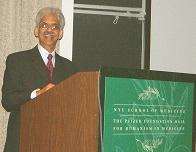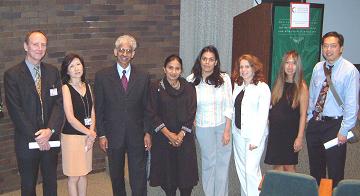Contribute
| Dr. Jayasankar Addresses NYU On South Asian Public Health |
Press Release
07/29/2004
When a 30 year old dies of a heart attack one wonders, why? Why do South Asians have a high rate of diabetes? Are these connected? We are all concerned, and Dr. Jay Jayasankar, a Boston orthopaedic surgeon and a Harvard faculty member decided that he needed to do something about it. “I took the leadership opportunity in the AAPI as a message from Providence to advance Indian American public health,” say the former AAPI President.
The seeds he sowed are nearing bloom and his efforts are drawing attention far and wide. The NIH funded and first of its kind CSAAH (Center for the Study of Asian American Health) at the New York University Medical School invited Dr. Jay, as he is affectionately known, to address them on the public health scourge that diabetes is among South Asians and his efforts in this area. Not only was the lecture much valued, but also the Center is keen on collaborating with him.
Studies in UK, South Africa, Singapore, Fiji and Trinidad have shown a high prevalence of heart disease and diabetes among South Asians and that the vulnerability starts in childhood. CDC (Centers for Disease Control) places the prevalence of diabetes in the US at about 5% in 2002. The New Castle Heart Project in England showed that among 25 to 74 year old South Asians, 23% had diabetes, 30% were prediabetic and less than half had normal blood sugar. Studies show that diabetes predisposes to heart disease as also do abnormal blood sugar, poor use of insulin by the body (called insulin resistance) and being overweight in the midsection (big waist) and metabolic syndrome and they are all common amongst South Asians.
Says Dr. Jay, “This bothered me as it does all of us and I started efforts to learn more about the problem in Indian Americans and to educate our community.” He was instrumental in focusing AAPI’s efforts in this direction and for creating DIA (Diabetes among Indian American) Initiative. Through his relationship with the Pfizer Medical Humanities Initiative, he was able to obtain a very substantial grant to AAPI to start this research. This was the first external grant to the AAPI. This seed money helped the AAPI leaders working as a team under his stewardship on focused legislative advocacy to obtain an additional pilot grant of $ ½ million from the US Congress through the CDC. Research is ongoing at several US and Indian sites through the Mayo Clinic, Arizona Heart Institute, University of Texas at Dallas and at Texas A&M.
“Standards used for screening are not sensitive enough for use in South Asians,” says Dr. Jay. “Studies show that the thresholds such as for body weight and waist circumference need to be set much lower to identify those at risk.”.
Can we do some thing about it? What can we do to stay healthy and keep our children healthy? “These questions bothered me,” adds Dr. Jay, “as I first got involved in the issue some years ago. The ultimate question is how can we prevent it. Many of us are vegetarians. Not many of us smoke. Our lifestyles are relatively simple. Don’t these make for less risk for diabetes and heart disease? The reality is that with all that we are more susceptible and we have to recognize it. That is the first step to prevention.”
In his talk at NYU, he shared with the experts the ethnic and cultural differences in health and disease behavior and in disease burden and the scientific nuances in understanding the different patterns and the need to understand them if we are to be successful in our public health efforts and the national goal of “Healthy People- 2010.”
Here is his prevention mantra:
And the prevention message for us all is:
Ø Eat right- watch the nutrition and the calories in your diet
Ø Maintain optimal weight and waist line- the cut off is lower for the South Asians, and
Ø Exercise regularly.
Ø And teach your children the habits while young and
Ø See your doctor regularly and tell them what you know about diabetes being more common in South Asians.
And the message for doctors and health care workers is:
Ø High prevalence of diabetes, insulin resistance and heart disease among South Asians
Ø Use more stringent screening thresholds and
Ø Start efforts in childhood
“The book on the nutritional value of Indian foods that was put together by volunteers led by Padmini Balagopal and Rita Batheja and under the guidance of Dr, Thakor Patel and published under my stewardship by the AAPI is a very useful tool in understanding our foods in this context,” Dr. Jay beams.
His message to the AAPI is to increase its commitment to Indian American public health, which is its responsibility as the premier ethnic medical society, have a long term strategy of continuing alliances and programs through the yearly leadership change and enhance the transparency and firewalls in managing grant monies.
You may also access this article through our web-site http://www.lokvani.com/

